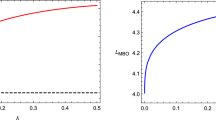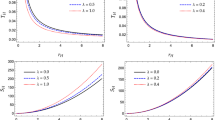Abstract
BLACK holes are now the subject matter of at least half the papers in general relativity. These papers rest on a foundation of sand, for black holes have been successfully defined only in asymptotically flat spacetimes, and no one really believes that the Universe is asymptotically flat. I shall provide a firm basis for black hole physics in the present paper; I shall extend the concept of ‘black hole’ to arbitrary stably causal spacetimes by essentially defining a black hole to be that object which contains all the ‘small’ trapped surfaces. As for most astrophysical applications black hole surfaces are located approximately by the outermost trapped surface boundary, this new definition allows results which depend only on the local behaviour of black holes in asymptotically flat spacetimes to be extended (approximately) to closed universes. Results which depend on the global behaviour of black holes cannot in general be extended to closed universes. For example, it is shown that the black hole area theorem—the statement that black holes never decrease their cross-sectional area—cannot be extended to closed universes. The new concept of black hole yields a purely geometrical definition of time direction in closed universes. My notation will be that of ref. 1.
Similar content being viewed by others
References
Hawking, S. W. & Ellis, G. F. R. The Large Scale Structure of Spacetime (Cambridge University Press, Cambridge, 1973).
Hawking, S. W. Phys. Rev. Lett. 15, 689 (1965).
Wheeler, J. A. The Physicist's Conception of Nature (ed. Mehra, J.), 202 (Reidel, Dordrecht, 1973).
Ellis, G. F. R. & Schmidt, B. G. J. gen. Rev. Grav. (in the press).
Tipler, F. J. Phys. Lett. A (in the press).
Penrose, R. Techniques of Differential Topology in Relativity (Society for Industrial and Applied Mathematics, Philadelphia, 1972).
Einstein, A. & Strauss, E. G. Rev. mod. Phys. 17, 120 (1945); 18, 148 (1946).
Penrose, R. Confrontation of Cosmological Theories with Observational Data (ed. Longair, M. S.), 263 (Reidel, Dordrecht, 1974).
Davies, P. C. W. Mon. Not. R. astr. Soc. 177, 179 (1977).
Author information
Authors and Affiliations
Rights and permissions
About this article
Cite this article
TIPLER, F. Black holes in closed universes. Nature 270, 500–501 (1977). https://doi.org/10.1038/270500a0
Received:
Accepted:
Issue Date:
DOI: https://doi.org/10.1038/270500a0
- Springer Nature Limited
This article is cited by
-
Information Recovery with Hawking Radiation from Dynamical Horizons
International Journal of Theoretical Physics (2014)
-
Lifshitz spacetimes, solitons, and generalized BTZ black holes in quantum gravity at a Lifshitz point
Journal of High Energy Physics (2014)
-
Asymptotically FRW black holes
General Relativity and Gravitation (2010)
-
Asymptotes of solutions of a perfect fluid coupled with a cosmological constant in four-dimensional spacetime with toroidal symmetry
General Relativity and Gravitation (2006)
-
No-Go theorem in spacetimes with two commuting spacelike killing vectors
General Relativity and Gravitation (2005)





